Or try one of the following: 詹姆斯.com, adult swim, Afterdawn, Ajaxian, Andy Budd, Ask a Ninja, AtomEnabled.org, BBC News, BBC Arabic, BBC China, BBC Russia, Brent Simmons, Channel Frederator, CNN, Digg, Diggnation, Flickr, Google News, Google Video, Harvard Law, Hebrew Language, InfoWorld, iTunes, Japanese Language, Korean Language, mir.aculo.us, Movie Trailers, Newspond, Nick Bradbury, OK/Cancel, OS News, Phil Ringnalda, Photoshop Videocast, reddit, Romanian Language, Russian Language, Ryan Parman, Traditional Chinese Language, Technorati, Tim Bray, TUAW, TVgasm, UNEASYsilence, Web 2.0 Show, Windows Vista Blog, XKCD, Yahoo! News, You Tube, Zeldman
ongoing by Tim Bray
ongoing fragmented essay by Tim BrayStorage Churn 5 May 2024, 7:00 pm
What are the highest-impact Cloud services? Storage would be near the top of any list. Where by “Storage” I mean what S3 does: Blobs-of-bytes storage that is effectively unlimited in capacity, credibly more durable than anything you could build yourself, and easily connected to the world, either directly or through a CDN. I think we’re entering a period of churn where there’s going to be serious competition on storage price and performance. Which, by the way, is crucially relevant to the Fediverse.
Let’s start with AWS, since they invented the modern Storage concept. The most important thing about S3 is this: There appear to be zero credible reports of S3 data loss. Given the number of objects it holds, and the numbers of years it’s held them, that’s remarkable.
It’s a safe place to store your data. Yeah, the API is a little klunky, and the latency can be high, and the hardwired bucket/object hierarchy is annoying, and so are the namespace issues. And it’s not cheap.
But it’s safe. And fast enough to be useful. And safe. And dead easy to connect up to a CDN. And did I mention that it’s safe?
S3…
AWS, to their credit, aren’t resting on their laurels. Here is a good Register interview with Andy Warfield, one of the lead S3 engineers and also a really good person. He’s talking about another variation on the basic S3 service, called “Express”, which has more filesystem-y semantics, higher performance, but (reading between the lines) a little less durability? (Also, more expensive.)
What’s notable about S3 isn’t this particular feature, but the fact that AWS keeps rolling out new ones. So it’s a moving target for the emerging competition.
…but cheaper…
In recent years and especially over the last few months, alternatives and competitors to S3 keep crossing my radar. A bunch of them have a premise that’s essentially “S3-compatible, but cheaper”: Backblaze B2, Digital Ocean Spaces, Wasabi, IDrive e2, Cloudflare R2, and Telnyx Cloud Storage. I’m sure I’ve missed some.
…and faster!
Some of the products claim to be way faster. Which matters if it’s true, but so far I don’t know of any popular benchmarking standards, so I’d take the numbers with a grain of salt. If I really cared, for a big project, I’d want to try it with my own code.
Here are a few of those:
S2
See Designing serverless stream storage. This is still more a research project than a product, but I drop it in here because it says that access to S3 Express made it possible. Its claim to fame appears to be higher performance.
Tigris
Tigris offers what they describe as “Globally Distributed S3-Compatible Object Storage”. I think the best description of what that means is by Xe Iaso of Fly.io, in Globally Distributed Object Storage with Tigris. It’s not just well-written, it’s funny. Apparently Fly.io bundles Tigris in, with command-line and billing integration.
Bunny
The fastest object storage, replicated to the edge is their big claim.
CDN?
Bunny sounds like it’s partly a CDN. And it’s not the only one. Which makes obvious sense; if you want to deliver the stuff you’re storing to users around the world at scale, you’re going to be hooking your storage and CDN together anyhow. So those lines are going to stay blurry.
Compatibility and intellectual property
S3 compatibility is an issue. It’s interesting that AWS has apparently decided not to defend the S3 API as intellectual property, and so these things cheerfully claim 100% plug-compatibility. And when they don’t have it, they apologize (that apology looks unusually far under the covers; I enjoyed reading it).
Durability?
They may claim compatibility, but mostly do not claim equivalent durability. I’ll be honest; if I were picking one, that would worry me. I’d need to see pretty full disclosure of how the services work under the covers.
Unknowns
I just mentioned durability, which is a technology issue. The other big unknowns are about business not technology. First of all, can you sustainably make money selling storage at a price that undercuts AWS’s? I haven’t the vaguest idea.
Second, is this a threat to AWS? There is a vast amount of data that is never gonna migrate off S3 because who’s got the time for that, but if the competition really can save you a lot of money that could hit S3’s growth hard, and Amazon wouldn’t like that. Who knows what might happen?
Now let’s change the subject.
Fediverse storage
I’ll use myself as a Fediverse example. As I write this, my @timbray@cosocial.ca Mastodon account has just over 18K followers, distributed across 3K-and-change instances. So whenever I post a picture or video, each of those instances fetches it and then keeps its own copy, if only in a short-lived cache.
All these files are immutable and identical. Smell an opportunity? Yeah, me too. Someone needs to build an object-store/CDN combo (I’ve already heard people say “FDN”). The API should cater to Mastodon’s quirks. You could split the cost equally or deal it out in proportion to traffic, but either way, I think there’d be big cost savings for nearly every instance.
Furthermore, it doesn’t feel technically challenging. If I were still at AWS, I’d be working on a PR/FAQ right now. Well, except for, since everything is S3-compatible and CDNs are commoditized, it would be plausible (and attractive) to build your FDN in a way that doesn’t tie you to any particular infrastructure provider.
Someone has already started on this; see Jortage Communal Cloud; small as of yet, but pointing in the right direction.
Fun times!
The storage world is a market with no monopolist, where providers are competing on price, performance, and durability. Be still my beating heart.
Photointegrity 29 Apr 2024, 7:00 pm
In March of 2004, just over twenty years ago, I published an ongoing piece entitled, like this one, “Photointegrity”. The issue remains the same, but the rise of AI increases its importance and its difficulty. Here are words on the subject, illustrated by photos all of which have been processed with AI technology.

Tulip blossom, captured with twenty-year old analog technology, enhanced with AI.
There’s an amusing story about the technology behind these flower pictures, down at the bottom of this piece.
Back in 2004
I was already using Photoshop but in fully-autodidactic mode, so I thought I should read a book about it, and selected one by Scott Kelby, “The Photoshop guy” back then and still active in the space, two decades later. It was a good book, but I was left wide-eyed and shocked: I’ll quote from that piece for those of you who don’t want to step back twenty years in time and read it:
Personal Improvement
In particular, Kelby walks through an astounding list of techniques for improving portraits, and I quote: removing blemishes, removing dark circles under the eyes, lessening freckles or facial acne, removing or lessening wrinkles, colorizing hair, whitening the eyes, making eyes that sparkle, enhancing eyebrows and eyelashes, glamour skin softening, transforming a frown into a smile, doing a digital nose job, slimming and trimming, removing love handles, and finally slimming buttocks, arms and thighs.
Integrity?
Screw it, integrity is history. The image is no longer the capture of a instant’s light and colour, it’s, well… whatever you and Photoshop make of it.
Photointegrity
I proposed a definition at the time: “what I’m going to do is strive to balance Truth and Beauty. In practical terms, this means the goal is make the picture look as much as possible like what I saw, as opposed to as good as possible.”

Simple yellow flower, captured with twenty-year old analog technology, enhanced with AI.
I can’t claim that I follow that strictly; most of the pictures in this space come out of the camera looking less pleasing than what I remember seeing, but I will confess that the version you see is often prettier than that memory. Usually, that results from the application of a bunch of Adobe technologies.
Is that OK? It’s a judgment call. Is there anything that isn’t a judgment call? Funny you should ask, because Adobe just announced the Firefly Generative AI 3 model, around which the next version of Photoshop is being built. Hitting those links and just scrolling through the pictures will give you a feeling for what this software will do.
Let me put a stake in the ground. I believe these things:
If you use generative tools to produce or modify your images, you have abandoned photointegrity.
That’s not always wrong. Sometimes you need an image of a space battle or a Triceratops family or whatever.
What is always wrong is using this stuff without disclosing it.
The C2PA angle
Last October, I wrote up C2PA, a useful digital watermarking technology that can be used to label images and video. That piece’s predictions look like they’re coming true; several manufacturers have announced C2PA support. I’m not going to take the space here to describe C2PA again.
I do note that Photoshop already supports C2PA and when it writes a watermark saying “Edited with Photoshop”, that label includes a very few words about what it did: cropping, levels adjustment, and so on; no details.
I believe strongly that when people use Adobe’s Firefly generative AI to create or augment pictures, Photoshop should by default turn C2PA labeling on, and disclose in the watermark whether it is fully-generated or just augmented. Sure, the person generating the image can always take that watermark out, but they can’t change its contents, and assuming C2PA becomes ubiquitous, the absence of a watermark would be reasonable grounds for suspicion.

Fruit tree blossoms, not open yet, captured with twenty-year old analog technology, enhanced with AI.
AI + photointegrity?
Over the last couple of years, the way I use Adobe Lightroom has changed a whole lot, and it’s mostly because of AI. Specifically, smart select. Lightroom now offers Select functions for Subject, Background, Sky, and Object. There’s also a very useful “Duplicate and invert” for any selection. I use these for almost every photo I take, especially Select Sky. The amount of light in the sky differs from that down here on the surface, and I’m pretty sure that our eyes compensate for that. Almost every picture looks more “real” when you select the sky and dial the brightness down (rarely: up) a touch, and maybe bump the contrast a bit.
This photo would have been a complete failure without those tools.

Allyson’s parents speak to the crowd at her memorial.
Recently we were at a memorial social for our recently-deceased friend Allyson. It was on a rooftop, on a bright grey day; the volume of light coming out of the sky was insane, and kept turning my photographic subjects into dark silhouettes.
The photo of Ally’s parents addressing the crowd is not great (her mom’s eyes are closed) but it at least captures a moment. The original was totally unusable, because the subjects are under a canopy and thus shaded, while the sky and cityscape and even mountains were reflecting harshly. So you select the subject, you invert and duplicate, you add light to the subject and subtract from the rest, and you get something that looks exactly like what I saw.
Of course, this depends on a good camera with a lot of dynamic range that can fish detail out of shadows.
I think this process retains photointegrity.
AI-enhanced analog
What happened was, the sun came out after the rain, everything is blooming this time of year, and I wanted to take pictures. I was rummaging for lenses and there was this dark shape at the back of the shelf. “What’s that?” I thought. It turned out to be an old Pentax with “Macro” in its name. Just the thing! Here’s what the combo looks like.


By the way, one reason the Internet is still good is that random enthusiasts maintain obscure databases, for example of camera lenses, from whence this smc Pentax-D FA 100mm F/2.8 Macro, an alternate version of which rejoices in the name “Schneider-Kreuznach D-Xenon”. It seems to have been manufactured only around 2004. I wrote about buying it in 2011 and shooting flowers and dancers with it in 2014; lotsa groovy pix in both.
Anyhow, this lens does a fabulous job of isolating foreground and background. Given this to chew on, Lightroom’s AI gizmo does a fabulous job of selecting just the flower (or background). So it’s easy to sharpen the flower and fade the bokeh; the old lens and the bleeding-edge software were made for each other.
But I digress.
Photointegrity matters
It mattered in 2004 and it matters more every passing year as our level of trust in online discourse falls and the power of generative AI grows. We have the tools to help address this, but we need to think seriously, and use them when appropriate.
Mobile Typing Pain 24 Apr 2024, 7:00 pm
I ran a Fediverse poll asking how people go about entering text on mobile devices. The results shocked me: Half the population just taps away. Do you? Read on for details and speculation.
This ongoing fragment embeds links to previous fragments, because I’ve been worrying and writing about this problem for a long time. Which in itself is interesting, more evidence that the problem is hard.
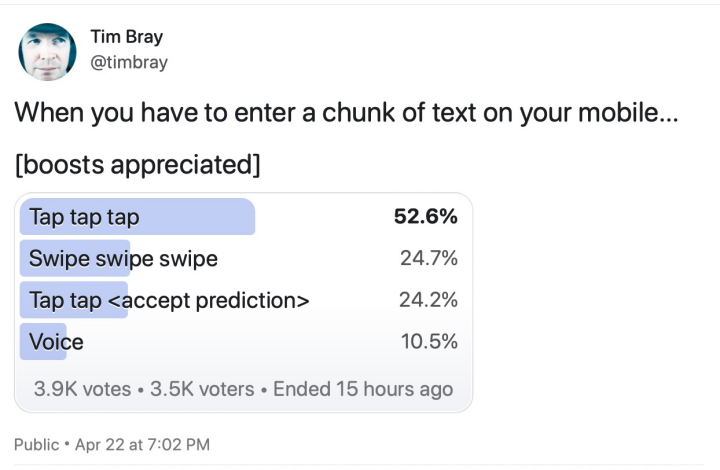
The poll post and (long) chain
of responses are
here on Mastodon.
People care
First, 3.5K poll responses is more than I usually see on the Fediverse; evidence that plenty of people have feelings about this. To reinforce that impression, scroll down through the responses (there are dozens). Many say, essentially, “Entering text on a mobile device is too hard, so I don’t.”
I’m one of those; I regularly start entering a message into a phone, stop, get up, and walk across the room to a real keyboard.
Tap tap wow
I widened my eyes when I saw that half the respondents testify to tapping along letter by letter. I could never. But then I have big fat farmer’s fingers with soft ends, and am not terribly dextrous.
But, probably, I shouldn’t have been surprised; 21 years ago in this blog I remarked that “it's pretty impressive to watch a Japanese person pounding text into their PDA at high speed using just their thumbs.” And today I watch teenage digits dance on devices like maddened maenads; they seem not to find it tedious.
Swiping etc
A quarter of poll respondents reported swiping words into their phones.
I mentioned above that people have been working on this for a long time. Check out this progress report from ongoing in 2011. It’s worth noting that Android’s input method being replaceable was important in driving this innovation.
My own proposal, the Digitator, has failed to break through.
That piece concludes “Anyhow, I’m pretty sure that something will come along.” But on the evidence it hasn’t, really.
The AI angle: Auto-predict and voice
The least popular poll options were tap-plus-autopredict and voice. I guess I’m weird, because those are what I mostly use. I suspect many others should too but don’t, probably because they tried those things a while ago and haven’t revisited them recently.
In my experience (which, granted, is almost all on Google Pixel devices) the autopredict and voice options have gotten stronger with almost every release. Not just a little bit stronger, either. Perhaps it’s just because I’m the white male Anglophone “canonical human” that designers build for, but I get dramatically better results than I used to.
Now obviously, most reasonable people will only talk to their phone when they’re in a private place, which limits the use of that option. But if you can find privacy, the voice option is getting remarkably good.
Which is to say, I can enter message or email text in at a pace that is sometimes adequate. Do I enjoy doing this? No, I hate it, as I noted above, and will make a real effort to switch to a keyboard.
In particular if what I want to enter is important, might matter.
Because anything that matters deserves editing, and it’s rare indeed that I hit “Send” on a first draft. And while brute-force text entry is edging into adequacy, editing remains a pool of pain.
Subtext
Two and a half decades into this millennium, the most popular communication products are optimized for consumption and barely adequate for creation. If I were paranoid and cynical, I might suspect that this is no accident. Oh wait, I am. But in fact I think it’s just a hard problem.
Meta.ai Oh My! 18 Apr 2024, 7:00 pm
“Meet Your New Assistant” says the announcement, going on with “Built With Llama 3”. And oh my goodness has it ever got a lot of coverage. So I thought I might as well try it.
My first cut was a little unfair; I asked it about a subject on which I am unchallenged as the world’s leading expert: Tim Bray. (That’s probably overstating it: My wife is clearly in the running.)
So I asked meta.ai “What does Tim Bray think of Google?” Twice; once on my phone while first exploring the idea, and again later on my computer. Before I go on, I should remark that both user interfaces are first-rate: Friction-free and ahead of the play-with-AI crowd. Anyhow, here are both answers; it may be relevant that I was logged into my long-lived Facebook account:
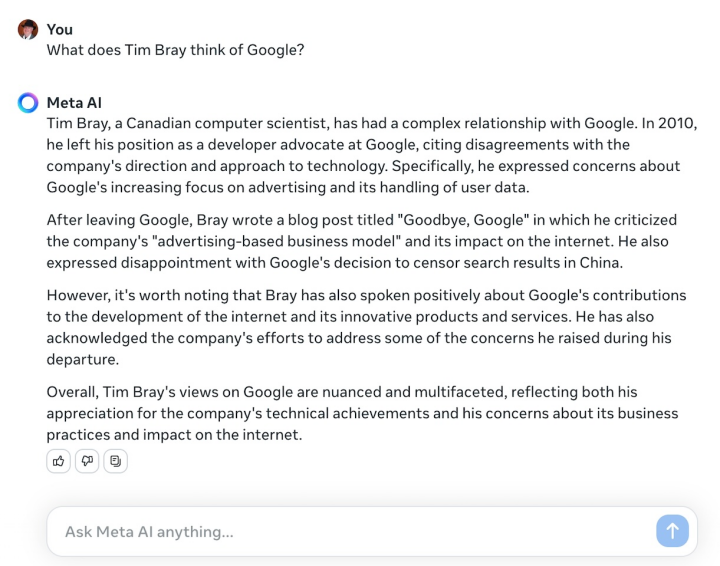
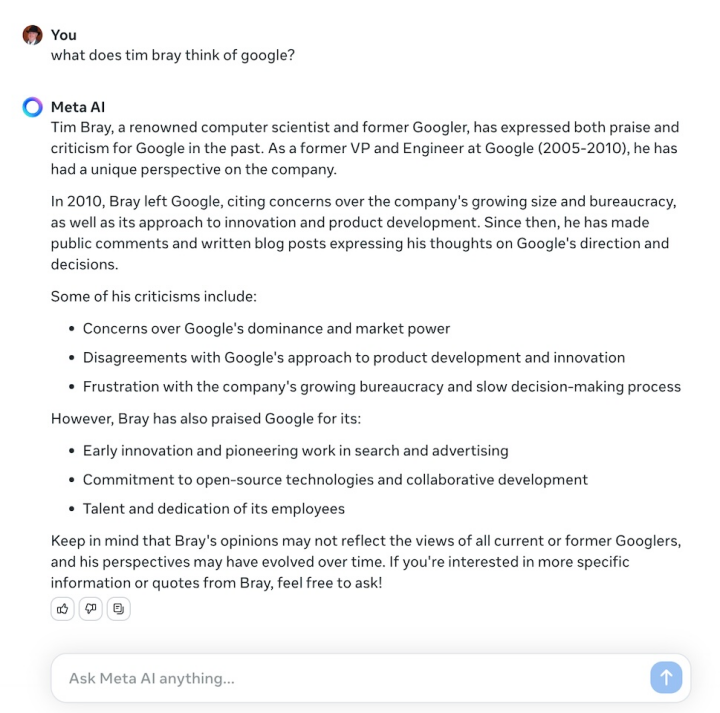
The problem isn’t that these answers are really, really wrong (which they are). The problem is that they are terrifyingly plausible, and presented in a tone of serene confidence. For clarity:
I am not a Computer Scientist. Words mean things.
I worked for Google between March of 2010 and March of 2014.
I was never a VP there nor did I ever have “Engineer” in my title.
I did not write a blog post entitled “Goodbye, Google”. My exit post, Leaving Google, did not discuss advertising nor Google’s activities in China, nor in fact was it critical of anything about Google except for its choice of headquarters location. In fact, my disillusionment with Google (to be honest, with Big Tech generally) was slow to set in and really didn’t reach critical mass until these troubling Twenties.
The phrase “advertising-based business model”, presented in quotes, does not appear in this blog. Quotation marks have meaning.
My views are not, nor have they been, “complex and multifaceted”. I am embarrassingly mainstream. I shared the mainstream enchantment with the glamor of Big Tech until, sometime around 2020, I started sharing the mainstream disgruntlement.
I can neither recall nor find instances of me criticizing Google’s decision-making process, nor praising its Open-Source activities.
What troubles me is that all of the actions and opinions attributed to meta.ai’s version of Tim Bray are things that I might well have done or said. But I didn’t.
This is not a criticism of Meta; their claims about the size and sophistication of their Llama3 model seem believable and, as I said, the interface is nifty.
Is it fair for me to criticize this particular product offering based on a single example? Well, first impressions are important. But for what it’s worth, I peppered it with a bunch of other general questions and the pattern repeats: Plausible narratives containing egregious factual errors.
I guess there’s no new news here; we already knew that LLMs are good at generating plausible-sounding narratives which are wrong. It comes back to what I discussed under the heading of “Meaning”. Still waiting for progress.
The nice thing about science is that it routinely features “error bars” on its graphs, showing both the finding and the degree of confidence in its accuracy.
AI/ML products in general don’t have them.
I don’t see how it’s sane or safe to rely on a technology that doesn’t have error bars.
Topfew Release 1.0 12 Apr 2024, 7:00 pm
Back in 2021-22, I wrote a series of blog posts about a program called “topfew” (tf from your shell command-line). It finds the field values (or combinations of values) which appear most often in a stream of records. I built it to explore large-scale data crunching in Go, and to investigate how performance compared to Rust. There was plentiful input, both ideas and code, from Dirkjan Ochtman and Simon Fell. Anyhow, I thought I was finished with it but then I noticed I was using the tf command more days than not, and I have pretty mainstream command-line needs. Plus I got a couple of random pings about whether it was still live. So I turned my attention back to it on April 12th and on May 2nd pushed v1.0.0.
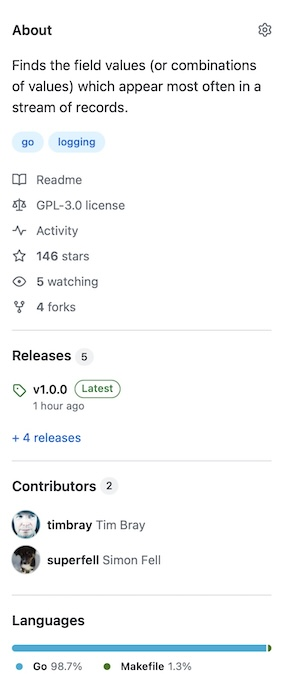
I added one feature: You can provide a regex field separator to override the default space-separation that defines the fields in your records. Which will cost you a little performance, but you’re unlikely to notice.
Its test coverage is much improved and, expectedly, there are fewer bugs. Also, better docs.
Plan
I think it’s pretty much done, honestly can’t think any useful new features. At some point, I’ll look into Homebrew recipes and suchlike, if I get the feeling they might be used.
Obviously, please send issues or PRs if you see the opportunity.
Who needs this?
It’s mostly for log files I think. Whenever I’m poking around in one of those I find myself asking questions like “which API call was hit most often?” or “Which endpoint?” or “Which user agent?” or “Which subnet?”
The conventional hammer to drive this nail has always been something along the lines of:
awk '{print $7}' | sort | uniq -c | sort -nr | head
Which has the advantage of Just Working on any Unix-descended computer. But can be slow when the input is big, and worse than
linear too.
Anyhow, tf is like that, only faster. In some cases, orders of magnitude faster. Plus, it has useful options
that take care of the grep and sed idioms that often appear upstream in the pipe.
Topfew’s got a decent README so I’m not going invest any more words here in explaining it.
But it’s worth pointing out that it’s a single self-contained binary compiled from standalone Go source code with zero dependencies.
Performance
This subject is a bit vexed. After I wrote the first version, Dirkjan implemented it in Rust and it was way faster, which annoyed me because it ought to be I/O-bound. So I stole his best ideas and then Simon chipped in other good ones and we optimized more, and eventually it was at least as fast as the Rust version. Which is to say, plenty fast, and probably faster than what you’re using now.
But you only get the big payoff from all this work when you’re processing a file, as opposed to a stream; then tf feels shockingly fast, because it divides the file up into segments and scans them in parallel. Works remarkably well.
Unfortunately that doesn’t happen too often. Normally, you’re grepping for something or teeing off another stream or whatever. In which case, performance is totally limited by reading the stream; I’ve profiled the hell out of this and the actual tf code doesn’t show up in any of the graphs, just the I/O-related buffer wrangling and garbage collection. Maybe I’m missing something. But I’m pretty sure tf will keep up with any stream you can throw at it.
Tooling
Over the years I’ve become an adequate user of GitHub CI. It’s good to watch that ecosystem become richer and slicker; the things you need seem to be there and for an OSS hobbyist like me, are generally free. Still, it bothers me that Everything Is On GitHub. I need to become aware of the alternatives.
I still live in JetBrains-land, in this case specifically Goland, albeit unfashionably in Light mode. It scratches my itches.
Anyhow, everything is easier if you have no dependencies. And our whole profession needs to be more thoughtful about its dependencies.
Dirty secret
I’ve always wanted to ship a two-letter shell command that someone might use. Now I have. And I do think tf will earn a home in a few folks’ toolboxes.
OSQI 1 Apr 2024, 7:00 pm
I propose the formation of one or more “Open Source Quality Institutes”. An OSQI is a public-sector organization that employs software engineers. Its mission would be to improve the quality, and especially safety, of popular Open-Source software.
Why?
The XZ-Utils backdoor (let’s just say #XZ) launched the train of thought that led me to this idea. If you read the story, it becomes obvious that the key vulnerability wasn’t technical, it was the fact that a whole lot of Open-Source software is on the undermaintained-to-neglected axis, because there’s no business case for paying people to take care of it. Which is a problem, because there is a strong business case for paying people to attack it.
There are other essential human activities that lack a business case, for example tertiary education, potable water quality, and financial regulation. For these, we create non-capitalist constructs such as Universities and Institutes and Agencies, because society needs these things done even if nobody can make money doing them.
I think we need to be paying more attention to the quality generally, and safety especially, of the Open-Source software that has become the underlying platform for, more or less, our civilization. Thus OSQI.
They’re out to get us
For me, the two big lessons from #XZ were first, the lack of resources supporting crucial Open-Source infrastructure, but then and especially, the demonstration that the attackers are numerous, skilled and patient. We already knew about numerous and skilled but this episode, where the attacker was already well-embedded in the project by May 2022, opened a few eyes, including mine.
The advantage, to various flavors of malefactor, of subverting core pieces of Open-Source infrastructure, is incalculable. #XZ was the one we caught; how many have we missed?
What’s OSQI?
It’s an organization created by a national government. Obviously, more nations than one could have an OSQI.
The vast majority of the staff would be relatively-senior software engineers, with a small percentage of paranoid nontechnical security people (see below). You could do a lot with as few as 250 people, and the burdened cost would be trivial for a substantial government.
Since it is a matter of obvious fact that every company in the world with revenue of a billion or more is existentially dependent on Open Source, it would be reasonable to impose a levy of, say, 0.1% of revenue on all such companies, to help support this work. The money needn’t be a problem.
Structure
The selection of software packages that would get OSQI attention would be left to the organization, although there would be avenues for anyone to request coverage. The engineering organization could be relatively flat, most people giving individual attention to individual projects, then also ad-hoc teams forming for tool-building or crisis-handling when something like #XZ blows up.
Why would anyone work there?
The pay would be OK; less than you’d make at Google or Facebook, but a decent civil-service salary. There would be no suspicion that your employer is trying to enshittify anything; in fact, you’d start work in the morning confident that you’re trying to improve the world. The default work mode would be remote, so you could live somewhere a not-quite-Google salary would support a very comfortable way of life. There would be decent vacations and benefits and (*gasp*) a pension.
And there is a certain class of person who would find everyday joy in peeking and poking and polishing Open-Source packages that are depended on by millions of programmers and (indirectly) billions of humans. A couple of decades ago I would have been one.
I don’t think recruiting would be a problem.
So, what are OSQI’s goals and non-goals?
Goal: Safety
This has to come first. If all OSQI accomplishes is the foiling of a few #XZ-flavor attacks, and life becoming harder for people making them, that’s just fine.
Goal: Tool-building
I think it’s now conventional wisdom that Open Source’s biggest attack surfaces are dependency networks and build tools. These are big and complex problems, but let’s be bold and set a high bar:
Open-Source software should be built deterministically, verifiably, and reproducibly, from signed source-code snapshots. These snapshots should be free of generated artifacts; every item in the snapshot should be human-written and human-readable.
For example: As Kornel said, Seriously, in retrospect, #autotools itself is a massive supply-chain security risk. No kidding! But then everyone says “What are you gonna do, it’s wired into everything.”
There are alternatives; I know of CMake and Meson. Are they good enough? I don’t know. Obviously, GNU AutoHell can’t be swept out of all of the fœtid crannies where it lurks and festers, but every project from which it is scrubbed will present less danger to the world. I believe OSQI would have the scope to make real progress on this front.
Non-goal: Features
OSQI should never invest engineering resources in adding cool features to Open-Source packages (with the possible exception of build-and-test tools). The Open-Source community is bursting with new-features energy, most coming from people who either want to scratch their own itch or are facing a real blockage at work. They are way better positioned to make those improvements than anyone at OSQI.
Goal: Maintenance
Way too many deep-infra packages grow increasingly unmaintained as people age and become busy and tired and sick and dead. As I was writing this, a plea for help came across my radar from Sebastian Pipping, the excellent but unsupported and unfunded maintainer of Expat, the world’s most popular XML parser.
And yeah, he’s part of a trend, one that notably included the now-infamous XZ-Utils package.
And so I think one useful task for OSQI would be taking over (ideally partial) maintenance duties for a lot of Open-Source projects that have a high ratio of adoption to support. In some cases it would have to take a lower-intensity form, let’s call it “life support”, where OSQI deals with vulnerability reports but flatly refuses to address any requests for features no matter how trivial, and rejects all PRs unless they come from someone who’s willing to take on part of the maintenance load.
One benefit of having paid professionals doing this is that they will blow off the kind of social-engineering harassment that the #XZ attacker inflicted on the XZ-Utils maintainer (see Russ Cox’s excellent timeline) and which is unfortunately too common in the Open-Source world generally.
Goal: Benchmarking
Efficiency is an aspect of quality, and I think it would be perfectly reasonable for OSQI to engage in benchmarking and optimization. There’s a non-obvious reason for this: #XZ was unmasked when a Postgres specialist noticed performance problems.
I think that in general, if you’re a bad person trying to backdoor an Open-Source package, it’s going to be hard to do without introducing performance glitches. I’ve long advocated that unit and/or integration tests should include a benchmark or two, just to avert well-intentioned performance regressions; if they handicap bad guys too, that’s a bonus.
Goal: Education and evangelism
OSQI staff will develop a deep shared pool of expertise in making Open-Source software safer and better, and specifically in detecting and repelling multiple attack flavors. They should share it! Blogs, conferences, whatever. It even occurred to me that it might make sense to structure OSQI as an educational institution; standalone or as a grad college of something existing.
But what I’m talking about isn’t refereed JACM papers, but what my Dad, a Professor of Agriculture, called “Extension”: Bringing the results of research directly to practitioners.
Non-goal: Making standards
The world has enough standards organizations. I could see individual OSQI employees pitching in, though, at the IETF or IEEE or W3C or wherever, with work on Infosec standards.
Which brings me to…
Non-goal: Litigation
Or really any other enforcement-related activity. OSQI exists to fix problems, build tools, and share lessons. This is going to be easier if nobody (except attackers) sees them as a threat, and if staff don’t have to think about how their work and findings will play out in court.
And a related non-goal…
Non-goal: Licensing
The intersection between the class of people who’d make good OSQI engineers and those who care about Open-Source licenses is, thankfully, very small. I think OSQI should accept the license landscape that exists and work hard to avoid thinking about its theology.
Non-goal: Certification
Once OSQI exists, the notion of “OSQI-approved” might arise. But it’d be a mistake; OSQI should be an engineering organization; the cost (measured by required bureaucracy) to perform certification would be brutal.
Goal: Transparency
OSQI can’t afford to have any secrets, with the sole exception of freshly-discovered but still-undisclosed vulnerabilities. And when those vulnerabilities are disclosed, the story of their discovery and characterization needs to be shared entirely and completely. This feels like a bare-minimum basis for building the level of trust that will be required.
Necessary paranoia
I discussed above why OSQI might be a nice place to work. There will be a downside, though; you’ll lose a certain amount of privacy. Because if OSQI succeeds, it will become a super-high-value target for our adversaries. In the natural course of affairs, many employees would become committers on popular packages, increasing their attractiveness as targets for bribes or blackmail.
I recall once, a very senior security leader at an Internet giant saying to me “We have thousands of engineers, and my job requires me to believe that at least one of them also has another employer.”
So I think OSQI needs to employ a small number of paranoid traditional-security (not Infosec) experts to keep an eye on their colleagues, audit their finances, and just be generally suspicious. These people would also worry about OSQI’s physical and network security. Because attackers gonna attack.
Pronunciation
Rhymes with “bosky”, of course. Also, people who work there are OSQIans. I’ve grabbed “osqi.org” and will cheerfully donate it in the long-shot case that this idea gets traction.
Are you serious?
Yeah. Except for, I no longer speak with the voice of a powerful employer.
Look: For better or for worse, Open Source won. [Narrator: Obviously, for better.] That means it has become crucial civilizational infrastucture, which governments should actively support and maintain, just like roads and dams and power grids.
It’s not so much that OSQI, or something like it, is a good idea; it’s that not trying to achieve these goals, in 2024, is dangerous and insane.
A057X 30 Mar 2024, 7:00 pm
Yes, “A057X” is cryptic, but my new lens’s official monicker is “150-500mm F/5-6.7 Di III VC VXD” so let’s stick with that part number. It’s from Tamron and this is the Fujifilm X-Mount variation. Lens-geeking is my favorite part of photo-geeking and it’s great that more manufacturers are opening up to third-party lens builders.
Last May I wrote that I wanted a big-ass super-telephoto and now I have one. Let’s start with a little comparo. Here is (roughly) the same 2km-away landscape shot on the decades-old Tokina 400mm I’d been using since 2009, and on the new Tamron.


If you care about this sort of thing you might want to enlarge these. A person is visible in the bottom picture, and another if you’re using Lightroom on a 4K screen.
Now let’s be honest; the color and flavor of the earlier picture is nicer, because the sun was just right; that’s why I strapped on the old glass. But the new-lens picture shows that yes, we do still make progress in analog technologies, and given the same light, there’d be more you could do with with today’s lens.
Anyhow, here’s what it looks like.
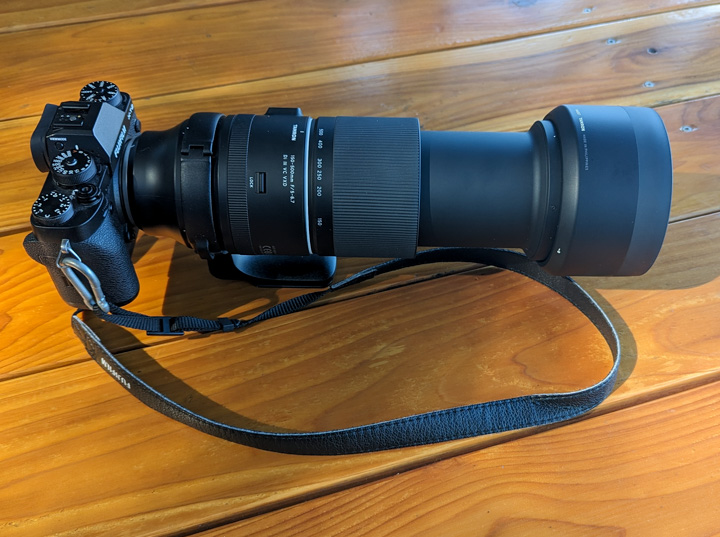
That’s on a Fujifilm X-T2, one of the bulkier of Fuji’s X-cameras. What’s not instantly obvious is that the camera and lens are sitting on the lens’s tripod shoe. That camera is now eight years old and needs to be replaced, but I’m not fully won over by the latest X-cams and the lens was an easier trigger to pull.
The reviews all said “Considering what it does, it’s amazingly small and light!” Maybe, but in fact it’s a big freakin’ heavy hunk of metal and glass. A tripod really helps.
For the birds
Tripod? But everyone seems to think that this kind of lens is for shooting birds in flight. So I took it to our cabin this weekend to test that hypothesis. Thus I learned that you really can’t shoot birds unless you’re hand-holding the camera. And even then, you can’t unless you’ve been practicing. I managed to get one picture of a bird in flight, but it was just a seagull and not a terribly handsome one either.
Then a couple of visitors settled at the top of a nearby Douglas Fir. Here’s one. Yes, the sky was that blue.

Isn’t it handsome? If you look close, though, its tail is jammed against a branch. But then it bent over to peer out at something.

Aren’t those feathers beautiful? This was a big-ass tree and I wasn’t right next to it, either. Yay Tamron.
Little, big
Turns out this thing can focus relatively close-in for an item of its ilk, so you can do, um what would one call it, macro-at-a-distance?

That’s a teeny little blossom. But when I’m looking out over the water, I always end up taking pictures of the mountains on the other side.

That one is a damn long way away. The picture suffers from being reduced to fit into your browser. I wish I could give everyone in the world Lightroom and a good 4K monitor.
Note that…
None of the pictures via this lens could have been captured on any mobile-phone camera in the world. You have to go pretty far these days to get into that territory.
Bye, Allyson 16 Mar 2024, 7:00 pm
She’s gone. She lived well. We’ll miss her.


We’ve known Ms McGrane since 2005, when she was a co-conspirator on the wonderful little local Northern Voice blogging conference. We worked on other stuff together and hung out now and then and carpooled to the Prairies once and I can’t remember ever getting the slightest bit upset with her.
Here is a good-bye note from her partner Shane. If you want to leave a note somewhere, leave it there.
Ally (rhymes with “valley”) was a fine dog-parent and a strong grant-writer and a first-rate teacher and a connoisseur of fine cooking equipment and Canadian football. If you’ve been to much in the way of Vancouver theatre and dance events over the years, there’s a good chance that she produced the event or secured its funding or educated the people who did those things.
I remember having coffee with her a couple years ago, she advising me on one of my projects, laughing together at the Byzantine complexities of granting bureaucracies and the childlike money-obliviousness of arts leaders and the excellence of the coffee on that morning. Easy to be with.
Mesothelioma is a bitch; 8% 5-year survival rate, and there wasn’t that much they could do for her by the time they got the diagnosis right. We visited her last week and she was herself, cynical about her situation but it seemed more or less at peace.
I won’t miss her as much as the dogs will, but there’s still a gap in my life.
Play My Music 10 Mar 2024, 7:00 pm
When I’m away from home, I still want to listen to the music we have at home (well, I can live without the LPs). We had well over a thousand CDs so that’s a lot of music, 12,286 tracks ripped into Apple Lossless. Except for a few MP3s from, well, never mind. This instalment of the De-Google Project is about ways to do that with less Big-Tech involvement.
The former Google Play Music, now YouTube Music, allowed you to load your tunes into the cloud and play them back wherever your phone or computer happened to be. Except for it used to be easy to upload — just point the uploader at your iTunes library — and now it’s hard, and then Google removed YouTube Music’s shuffle-your-uploads feature from Android Auto. Also they fired a bunch of YouTube Music contractors who were trying to unionize. So screw ’em.
I discovered three plausible ways to do this. First and most simply, dump the tunes onto a USB drive; wherever you are in the world, you can usually plug one in and play tunes from it.
Second, there’s Plex; you run a Plex server on one of your computers at home (in our case a recent Mac Mini) which you point at music and video directories, and it’ll serve them to clients on the Web or on phones or on platforms like WebOS and Roku.
Also, it’ll serve your media to anywhere in the world, using UPnP to drill an outgoing hole through your firewall. Obviously, this could make a security-sensitive person nervous and does bother me a bit, because UPnP’s history has featured some nasty vulnerabilities. I have a to-do to check whether the version on my dumbass telco ISP router is reasonably safe. I believe that Tailscale would offer a better security posture, but don’t want one more thing to manage.
Finally, Apple Music can apparently do what YouTube Music does; let you upload your tunes into the cloud and play them anywhere. But moving from one Big-Tech provider to another doesn’t feel like progress.
Does it work?
Setting it up on Plex was a Just-Works experience. The process even reached out through our modern Eero mesh to the old telco router and convinced it to set up the appropriate UPnP voodoo. If you open the Plex server admin interface it occasionally complains about a double-NAT situation but works anyhow.
Getting the USB working was kind of hilarious. First of all, I bought a 512G USB stick. (My Mac says it only has 460GB, but what’s 50G between friends?) USB-A because that’s what the car has. It took a couple of hours to copy all the music onto it.
Then I plugged the USB stick into the car and it showed up instantly in the “Sources” tab of the media player, but greyed out. I snickered when I noticed that all the car infotainment menus were crawling and stuttering. Asking the car’s mighty electronic brain to index that mountain of music was making it sweat. Anyhow, after a few minutes, I could access the USB and now it works fine, mostly.
By “mostly”, I mean that when I tell it to play music off the USB, it takes a few seconds for the music to start, then a minute or more to get its shit together and present a coherent picture of what it’s playing. And on one occasion, the music player just randomly switched over to the radio. So I suspect my inventory is pushing the poor little toy computer in the car pretty hard. But once it’s going, the presentation is nice:
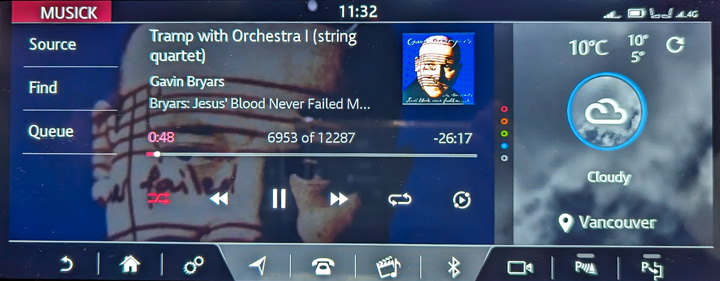
A few items to note here:
“Musick” is the name I gave the USB key.
That recording is Jesus’ Blood Never Failed Me Yet, a truly unique piece of work by British composer Gavin Bryars. Opinions vary; I think it’s magical but it’s one of the few pieces of music that I am absolutely forbidden to play anywhere my wife can hear it.
The car software is way more flexible than Android Auto; this is just one of the car’s three screens and there are a lot of options for distributing your music and weather and maps and climate control across them.
Which is better?
It’s complicated. Obviously, the USB option doesn’t require any network bandwidth. And I think the album-art presentation is nicer than Plex’s. (You can see that here).
The audio quality is pretty well a wash. Plex is a little louder, I suspect them of Loudness-War tactics, which is probably OK in a car with its inevitable background noise. Plex also crossfades the song transitions, clever and pleasing but really not essential.
Plex is really nice software and I feel a little guilty that I’m not sending them any money. They do have a “Pro” level of service; must check it out.
Then of course Plex needs Android Auto. Which on the one hand I’m probably going to be running a lot if I’m driving around town to appointments. But… Android Auto is already a little shaky some days, not sure whether it’s crashing or the car software is creaking or it’s just yet another lousy USB-C connection (I am developing a real hate for that form factor).
Realistically, given that our car (a Jaguar I-Pace EV) wasn’t a big seller and is five years old, can I really count on Google and Jaguar to do what it takes to keep Android Auto running?
At this point I need to say a big “Thanks!” to everyone on Fedi/Mastodon who gave me good advice on how to approach this problem.
Anyhow, as of now, we have two alternatives that work well. The De-Googling march continues forward.
The De-Google Project 9 Mar 2024, 8:00 pm
My family, like most, depends on a lot of online services. And again like most, a lot of those services come from Big Tech giants in general and (in our case) Google in particular. And like many people, we are becoming less comfortable with that. So I’m going to try to be systematic about addressing the problem. This post summarizes our dependencies and then I’ll post blog pieces about updates as I work my way through the list. (The first is already posted, see below.)
I’m calling this the “De-Google” project because they’re our chief supplier of this stuff and it’s more euphonious than “De-BigTechInGeneral”.
| Need | Supplier | Alternatives |
|---|---|---|
| Office | Google Workspace | ? |
| Data sharing | Dropbox | ? |
| Video meetings | Google Meet | Jitsi, ? |
| Maps | Google Maps | Magic Earth, Here, something OSM-based |
| Browser | Apple Safari | Firefox, ? |
| Search | Bing-based options | |
| Chat | Signal | |
| Photo editing | Adobe Lightroom & Nik | Capture One, Darktable, ? |
| In-car interface | Google Android Auto | Automaker software |
| Play my music | Plex, USB | |
| Discover music | Google YouTube Music | Qobuz, Tidal, Deezer, Pandora, ? |
| TV | Prime, Roku, Apple, Netflix, TSN, Sportsnet | ? |
The “Supplier” color suggests my feelings about what I’m using, with blue standing for neutral.
Criteria
To replace the things that I’m unhappy with, I’m looking for some combination of:
Open source
Not ad-supported
Not VC-funded
Not Google, Apple, Microsoft, or Amazon
Office
We’ve been using Gmail for a really long time and are used to it, and the integration between mail and calendar and maps basically Just Works. The price is OK but it keeps going up, and so do our data storage requirements, what with all the cameras in the family. Finally, Google has stewardship of our lives and are probably monetizing every keystroke. We’re getting a bit creeped out over that.
I think that calendars and email are kind of joined at the hip, so we’d want a provider that does both.
As for online docs, I will not be sorry to shake the dust of Google Drive and Docs from my heels, I find them clumsy and am always having trouble finding something that I know is in there.
Data sharing
Dropbox is OK, assuming you ignore all the other stuff it’s trying to sell you. Maybe one of these years I should look at that other stuff and see if it’s a candidate to replace one or two other services?
Video meetings
I dislike lots of things about Zoom and find Microsoft Teams a pool of pain, but have been pretty happy with Google Meet. Nobody has to download or log into anything and it seems to more or less Just Work. But I’d look at alternatives.
Maps
As I wrote in 2017, Google maps aggregate directions, reviews, descriptions, phone numbers, and office hours. They are potentially a nuclear-powered monopoly engine. I use Maps more and more; if I want to contact or interact with something whose location I know, it’s way quicker to pull up Maps and click on their listing than it is to use Google search and fight through all the ads and spam.
The calendar integration is fabulous. If you have Android Auto and you’re going to a meeting, pull up the calendar app and tap on the meeting and it drops you right into directions.
The quality of the OpenStreetMap data is very good, but obviously they don’t have the Directions functions. Who does? Obviously, Here does, and I was enthused about it in 2019; but Android Auto’s music powers drew me back to Google Maps. Aside from that, Magic Earth is trying, and their business model seems acceptable, but the product was pretty rough-edged last time I tried it.
Browser
Safari is my daily driver. These days Chrome is starting to creep me out a bit; just doesn’t feel like it’s on my side. Also, it’s no longer faster than the competition. I’d like to shift over to Firefox one day when I have the energy
Then there are the Arcs and Braves and Vivaldis of this world, but I just haven’t yet invested the time to figure out if one of these will do, and I do not detect a wave of consensus out there.
By the way, DuckDuckGo has a browser, a shell over Safari on the Mac and Edge on Windows. Lauren uses it a lot. Probably worth a closer look.
Search
The decline of Google Search is increasingly in everyone’s face. Once again, it refuses to find things on this blog that I know are there.
Others in the family have already migrated to DuckDuckGo, and I now feel like an old-school lagger for still not having migrated off Google. I wish there were someone else taking a serious run at indexing the Web other than Bing — from yet another tech giant — but here we are.
Lauren tells me to have a closer look at Ecosia, which seems very wholesome.
Chat
At the moment you will have to pry Signal out of my cold, dead, hands. You should be using it too. ’Nuff said.
Photo editing
I pay my monthly tribute to Adobe, about whom my feelings aren’t as negative as they are about the mega Tech Giants. I’d like not to pay so much, and I’d like something that runs a little faster than Lightroom, and I’d like to support open source. But… I really like Lightroom, and sometimes one absolutely needs Photoshop, so I’m unlikely to prioritize this particular escape attempt.
In-car interface
Choices are limited. I see little point in migrating between Android Auto and CarPlay, which leaves the software the auto maker installed. Which, in my five-year-old Jaguar is… well, not bad actually. I think I could live with the built-in maps and directions from Here, even with the British Received Pronunciation’s butchery of North American place names.
But, I don’t know, we might stay with Android Auto. Check out this screenshot from my car.

(Pardon the blurs and distortions.)
This is Android Auto displaying, as it normally does when I’m driving, maps and music. By default, Google Maps and YouTube Music. But not here; on the right is Plex, playing my own music stored on a Mac Mini at home.
On the left, it’s even more interesting: This is neither Google maps nor a competitor; it’s Gaia GPS, the app I normally use to mark trail while bushwhacking through Pacific Northwest rain forests. Somehow I fat-fingered it into place either in the car or on my phone.
The lesson here is that (for the moment at least) Android Auto seems to be genuinely neutral. It knows the general concepts of “apps that play music” and “apps that are maps” and is happy to display whichever ones you want, not just Google’s. (As a former Android geek who knows about Intents and Filters, I can see how this works. Clever.)
So far, Android Auto doesn’t show ads, but I suppose it’s monetizing me by harvesting traffic information to enrich its maps and I guess that’s a bargain I can live with. I use that data myself when I want to go somewhere and there are multiple routes and I can see which one is backed up by sewer work or whatever.
Discover music
I’ve been paying for YouTube Music since before it existed, and I’m genuinely impressed with the way its algorithm fishes up new artists that it turns out I really like. But just now Google laid off a bunch of YouTube Music “contractors” (de facto, employees) who tried to organize a union, so screw ’em.
I haven’t investigated any of the alternatives in depth yet.
Play my music
In the decades where Compact Disks were the way to acquire music, I acquired a lot. And ripped it. And pushed it up into Google’s musical cloud. And (until recently) could shuffle my musical life on YouTube Music. But they removed that feature from Android Auto, so screw ’em.
But I now have two good ways to do this. Check this out in Play My Music.
TV
The same gripe as everyone else: The streaming services have re-invented Cable TV, which I only got around to dumping a couple of years ago. The right solution is obvious: Pay-per-view at a reasonably low price, then the services could compete on producing great shows that people will pay to see, rather than sucking you into yet another subscription.
I suspect this column will stay red for quite a while. It’s amazing how much business leaders hate simple business models where there’s a clean clear one-time price for a product and customers have a clean clear choice who they buy their products from.
The path forward
I don’t know if I’ll ever turn the center column all-green. And I don’t need to; progress is progress. Anyhow, doing this sort of investigation is kind of fun.
Money Bubble 25 Feb 2024, 8:00 pm
I think I’m probably going to lose quite a lot of money in the next year or two. It’s partly AI’s fault, but not mostly. Nonetheless I’m mostly going to write about AI, because it intersects the technosphere, where I’ve lived for decades.
I’ve given up having a regular job. The family still has income but mostly we’re harvesting our savings, built up over decades in a well-paid profession. Which means that we are, willy-nilly, investors. And thus aware of the fever-dream finance landscape that is InvestorWorld.
The Larger Bubble
Put in the simplest way: Things have been too good for too long in InvestorWorld: low interest, high profits, the unending rocket rise of the Big-Tech sector, now with AI afterburners. Wile E. Coyote hasn’t actually run off the edge of the cliff yet, but there are just way more ways for things to go wrong than right in the immediate future.
If you want to dive a little deeper, The Economist has a sharp (but paywalled) take in Stockmarkets are booming. But the good times are unlikely to last. Their argument is that profits are overvalued by investors because, in recent years, they’ve always gone up. Mr Market ignores the fact that at least some of those gleaming profits are artifacts of tax-slashing by right-wing governments.
That piece considers the observation that “Many investors hope that AI will ride to the rescue” and is politely skeptical.
Popping the bubble
My own feelings aren’t polite; closer to Yep, you are living in a Nvidia-led tech bubble by Brian Sozzi over at Yahoo! Finance.
Sozzi is fair, pointing out that this bubble feels different from the cannabis and crypto crazes; among other things, chipmakers and cloud providers are reporting big high-margin revenues for real actual products. But he hammers the central point: What we’re seeing is FOMO-driven dumb money thrown at technology by people who have no hope of understanding it. Just because everybody else is and because the GPTs and image generators have cool demos. Sozzi has the numbers, looking at valuations through standard old-as-dirt filters and shaking his head at what he sees.
What’s going to happen, I’m pretty sure, is that AI/ML will, inevitably, disappoint; in the financial sense I mean, probably doing some useful things, maybe even a lot, but not generating the kind of profit explosions that you’d need to justify the bubble. So it’ll pop, and my bet it is takes a bunch of the finance world with it. As bad as 2008? Nobody knows, but it wouldn’t surprise me.
The rest of this piece considers the issues facing AI/ML, with the goal of showing why I see it as a bubble-inflator and eventual bubble-popper.
First, a disclosure: I speak as an educated amateur. I’ve never gone much below the surface of the technology, never constructed a model or built model-processing software, or looked closely at the math. But I think the discussion below still works.
What’s good about AI/ML
Spoiler: I’m not the kind of burn-it-with-fire skeptic that I became around anything blockchain-flavored. It is clear that generative models manage to embed significant parts of the structure of language, of code, of pictures, of many things where that has previously not been the case. The understanding is sufficient to reliably accomplish the objective: Produce plausible output.
I’ve read enough Chomsky to believe that facility with language is a defining characteristic of intelligence. More than that, a necessary but not sufficient ingredient. I dunno if anyone will build an AGI in my lifetime, but I am confident that the task would remain beyond reach without the functions offered by today’s generative models.
Furthermore, I’m super impressed by something nobody else seems to talk about: Prompt parsing. Obviously, prompts are processed into a representation that reliably sends the model-traversal logic down substantially the right paths. The LLMbots of this world may regularly be crazy and/or just wrong, but they do consistently if not correctly address the substance of the prompt. There is seriously good natural-language engineering going on here that AI’s critics aren’t paying enough attention to.
So I have no patience with those who scoff at today’s technology, accusing it being a glorified Markov chain. Like the song says: Something’s happening here! (What it is ain’t exactly clear.)
It helps that in the late teens I saw neural-net pattern-matching at work on real-world problems from close up and developed serious respect for what that technology can do; An example is EC2’s Predictive Auto Scaling (and gosh, it looks like the competition has it too).
And recently, Adobe Lightroom has shipped a pretty awesome “Select Sky” feature. It makes my M2 MacBook Pro think hard for a second or two, but I rarely see it miss even an isolated scrap of sky off in the corner of the frame. It allows me, in a picture like this, to make the sky’s brightness echo the water’s.

And of course I’ve heard about success stories in radiology and other disciplines.
Thus, please don’t call me an “AI skeptic” or some such. There is a there there.
But…
Given that, why do I still think that the flood of money being thrown at this tech is dumb, and that most of it will be lost? Partly just because of that flood. When financial decision makers throw loads of money at things they don’t understand, lots of it is always lost.
In the Venture-Capital business, that’s an understood part of the business cycle; they’re looking to balance that out with a small number of 100x startup wins. But when big old insurance companies and airlines and so on are piling in and releasing effusive statements about building the company around some new tech voodoo, the outcome, in my experience, is very rarely good.
But let’s be specific.
Meaning
As I said above, I think the human mind has a large and important language-processing system. But that’s not all. It’s also a (slow, poorly-understood) computer, with access to a medium-large database of facts and recollections, an ultra-slow numeric processor, and facilities for estimation, prediction, speculation, and invention. Let’s group all this stuff together and call it “meaning”.
Have a look at Climbing towards NLU: On Meaning, Form, and Understanding in the Age of Data by Emily Bender and Alexander Koller (2020). I don’t agree with all of it, and it addresses an earlier generation of generative models, but it’s very thought-provoking. It postulates the “Octopus Test”, a good variation on the bad old Chinese-Room analogy. It talks usefully about how human language acquisition works. A couple of quotes: “It is instructive to look at the past to appreciate this question. Computational linguistics has gone through many fashion cycles over the course of its history” and “In this paper, we have argued that in contrast to some current hype, meaning cannot be learned from form alone.”
I’m not saying these problems can’t be solved. Software systems can be equipped with databases of facts, and who knows, perhaps some day estimation, prediction, speculation, and invention. But it’s not going to be easy.
Difficulty
I think there’s a useful analogy between the narratives around AI and of self-driving cars. As I write this, Apple has apparently decided that generative AI is easier than shipping an autonomous car. I’m particularly sensitive to this analogy because back around 2010, as the first self-driving prototypes were coming into view, I predicted, loudly and in public, that this technology was about to become ubiquitous and turn the economy inside out. Ouch.
There’s a pattern: The technologies that really do change the world tend to have strings of successes, producing obvious benefits even in their earliest forms, to the extent that geeks load them in the back doors of organizations just to get shit done. As they say, “The CIO is the last to know.”
Contrast cryptocurrencies and blockchains, which limped along from year to year, always promising a brilliant future, never doing anything useful. As to the usefulness of self-driving technology, I still think it’s gonna get there, but it’s surrounded by a cloud of litigation.
Anyhow, anybody who thinks that it’ll be easy to teach “meaning” (as I described it above) to today’s generative AI is a fool, and you shouldn’t give them your money.
Money and carbon
Another big problem we’re not talking about enough is the cost of generative AI. Nature offers Generative AI’s environmental costs are soaring — and mostly secret. In a Mastodon thread, @Quixoticgeek@social.v.st says We need to talk about data centres, and includes a few hard and sobering numbers.
Short form: This shit is expensive, in dollars and in carbon load. Nvidia pulled in $60.9 billion in 2023, up 126% from the previous year, and is heading for a $100B/year run rate, while reporting a 75% margin.
Another thing these articles don’t mention is that building, deploying, and running generative-AI systems requires significant effort from a small group of people who now apparently constitute the world’s highest-paid cadre of engineers. And good luck trying to hire one if you’re a mainstream company where IT is a cost center.
All this means that for the technology to succeed, it not only has to do something useful, but people and businesses will have to be ready to pay a significantly high price for that something.
I’m not saying that there’s nothing that qualifies, but I am betting that it’s not in ad-supported territory.
Also, it’s going to have to deal with pushback from unreasonable climate-change resisters like, for example, me.
Anyhow…
I kind of flipped out, and was motivated to finish this blog piece, when I saw this: “UK government wants to use AI to cut civil service jobs: Yes, you read that right.” The idea — to have citizen input processed and responded to by an LLM — is hideously toxic and broken; and usefully reveals the kind of thinking that makes morally crippled leaders all across our system love this technology.
The road ahead looks bumpy from where I sit. And when the business community wakes up and realizes that replacing people with shitty technology doesn’t show up as a positive on the financials after you factor in the consequences of customer rage, that’s when the hot air gushes out of the bubble.
It might not take big chunks of InvestorWorld with it. But I’m betting it does.
Social Photos 15 Feb 2024, 8:00 pm
I like taking pictures, and I like sharing pictures wherever I hang out online. A problem with this is knowing that the pictures will very rarely look as good in other people’s browsers and apps as they do to me in Lightroom on a big bright 4K screen. Thus this piece, a basic investigation of how photos are processed and transformed on Mastodon, Bluesky, and Threads.
I was never that much of an Instagram poster; Insta does a good job of taking your crappy phone pix and juicing them up with filters so they look way better. That’s irrelevant to me, because not only do I like taking pictures, I like polishing them with Lightroom and Silver Efex and so on. So with a few exceptions, everything I want to share gets pulled onto my Mac and edited before I share it. And once I’ve done that, why would I post pictures anywhere but where I have my normal conversations?
The picture
Here it is:

Taken with a Pixel 7 out an airplane window somewhere just west of Havre, Montana. It seems like there are two layers of clouds at the left of the picture but if you look closely, the lower one I think is the Rocky Mountains in the distance.
That’s a big picture, both in its subject and raw size: The Pixel version, after editing, is 3814x2290. Also it has a lot of fine detail, and rewards zooming in. When I post it, I’d like some sense of the bigness to come across, and when tapped to enlarge, I’d like it to wow people a little, especially those fortunate enough to be looking at big screens. And I’d like it to be at least OK on your phone.
Normally, pictures here in the blog are limited to max 720x720 in the column of text, and the larger version you get by clicking to 1440x960. But in this case, if you click you get a 2558x1536 version, the objective being that that’ll be big enough to fill almost any screen it gets viewed on.
Methodology and apology
The question I want to investigate is, “which platforms are going to make my pictures look good?” But I haven’t really figured out yet how to do that. To start with, what kind of picture is going to do best as a metric to judge the processing quality?
Anyhow, I picked this one and posted it to Mastodon, Bluesky, and Threads, and here gather data about the results. But hey, why not tap those links on whatever device you’re using right now and see what you think about how the picture looks there?
The columns are:
Bytes: the size of the photo as downloaded.
WxH: width and height, in pixels.
“Q”: the JPG quality, as reported by Imagemagick’s
identify --verbose. The quotes are there because I’m not sure how to interpret, or even whether it’s any use at all.
| Bytes | WxH | “Q” | ||
|---|---|---|---|---|
| Original | 1671514 | 2558 1536 | 94 | |
| Blog form | 624961 | 1440 865 | 94 | |
| Bluesky | Android FS | 302972 | 864 663 | |
| Bluesky | Android mini | 42410 | 345 345 | |
| Bluesky | Web FS | 536345 | 2000 1201 | 80 |
| Bluesky | Web mini | 112335 | 1000 601 | 80 |
| Mastodon | Web FS | 1555111 | 2558 1536 | 90 |
| Mastodon | Web mini | 86374 | 619 372 | 90 |
| Phanpy | Web FS | 1555111 | 2558 1536 | 90 |
| Phanpy | Web mini | 86374 | 619 372 | 90 |
| Threads | Web FS | 888067 | 2160 1297 | 90 |
| Threads | Web mini | 888067 | 2160 1297 | 90 |
Note that each of the posts included not one but two pictures, because I was also interested in how the platforms allocated screen space. The platforms typically have two display modes, “mini”, as shown in the feed, and “FS” for Full Size, what you get when you click on the picture.
Original/Blog form
I think that ideally, I’d like each platform’s presentation of the picture, when you click on it, to have the same number of pixels and for each pixel to have the same color value, as in my original.
Bluesky
First of all are numbers from the Android app, but please don’t take them seriously. The process of extracting them from the Pixel’s screen and getting them onto my Mac involved multiple irritating steps, each one of which may have damaged the bits. So I didn’t repeat the exercise for the other platforms. They are mostly here to encourage me, should I pursue this further, to find a good clean way to extract this information.
I do note, however, that the “mini” form in the Bluesky Android feed really crushes those poor little pictures down and, for this particular picture, offers no suggestion that it’s big.
The Web version of Bluesky does not preserve my pixels, but coerces the size down to 2K and 1K width in FS and mini versions.
Mastodon and Phanpy
Phanpy is an alternate client for Mastodon; I think it’s very good and it’s my daily driver. The table reveals that, in this case, the alternate client pulls in the same images as the official Web client, which is good.
It also reveals that Mastodon preserves the picture’s dimensions, but obviously reprocesses it somehow, because the photos grow (somewhat) smaller. I wish they didn’t do that. It’s open-source, I should peek in and see what they actually do.
Phanpy does a better job of actually showing the pictures in-feed than the official Mastodon client, and both are nicer than Bluesky.
Threads
I had difficulty, because the Threads Web client is a tangly JavaScript fever dream, so it’s really hard to get at the underlying photos, but my efforts suggested that it uses the same picture for the “mini” and “FS” versions, just getting the browser to scale them down.
Furthermore, Threads doesn’t want pictures to be more than 2160 pixels wide.
Maybe I’m wrong
Because the experimental work was manual and thus highly prone to fumblefingers and brain farts. If you think that any of these numbers are wrong, you may be right; please yell at me.
I hesitate to offer a conclusion because this is, as noted at the top, the first steps in what could be a large and interesting research project, one that I probably don’t have the expertise to conduct. But, here are a few anyhow.
First, they all do a pretty good job. Second, none of them actually offer an opportunity to view my bits exactly as uploaded, which I think they should. Third, client designers should follow Phanpy’s lead in figuring out how to make better use of screen real-estate to highlight images.
What Lewis Carroll Said
And I quote: “What is the use of a book,” thought Alice, “without pictures or conversations?”
Vision 1993 2 Feb 2024, 8:00 pm
I’ve plowed through the first wave of AVP (Apple Vision Pro) reviews, and it seems pretty obvious that, at the current price and form factor, it’s not gonna be a best-seller. But I remain a strong believer in Augmented Reality (the AVP is VR not AR, for the moment). As I was diving into the reviews, a little voice in the back of my head kept saying “I once read about what this is trying to be.”

What I was remembering was Virtual Light, a 1993 novel by William Gibson, allegedly set in 2006. It paints a clear picture of a future that includes AVP’s descendants. So I re-read it. Maybe looking back is the way to look forward.
But first…
I wanted to say: It’s a terrific book! If you haven’t read it you might really like it. I hadn’t in years and I sure enjoyed the re-read. The people in it are charming, and it’s built around a fabulous physical artifact that drives the plot. No, I don’t mean AR goggles, I mean San Francisco’s Bay Bridge, which in Virtual Light and two subsequent novels, has been wrecked by an earthquake and become a huge countercultural shantytown, one of the coolest venues Gibson has ever invented, and that’s a strong statement. Also, protagonists Chevette and Rydell are two of his best characters; another strong statement.

Anyhow, I don’t think it’s much of a spoiler to say that the AR devices I’m writing about, despite being what the title refers to, are peripheral to the plot. It turns out that one such device contains information that’s secret enough to attract hired killers, skip tracers, and crooked Homicide cops to recover it when it gets stolen; plenty of plot fuel right there.
Quoting
Here are a few out-takes from the book describing the titular technology.
Quote:
Nothing in it but a pair of sunglasses, expensive-looking but so dark she hadn’t even been able to see through them last night.
Quote:
…she took that case out.
You couldn’t tell what it was made of, and that meant expensive. Something dark gray, like the lead in a pencil, thin as the shell of one of those eggs, but you could probably drive a truck over it… She’d figured out how you opened it the night before: finger here, thumb there. It opened. No catch or anything, no spring… Inside was like black suede, but it gave like foam under your finger.
Those glasses, nested there. Big and black. Like that Orbison in the poster… She pulled them from the black suede… They bothered her … they weighed too much. Way too heavy for what they were, even with the big earpieces. The frames looked as though they’d been carved from slabs of graphite.
She put them on. Black. Solid black.
“Katharine Hepburn.” Skinner said.
Quote:
Warbaby wore a black Stetson set dead level on his head, the brim turned up all the way around, and glasses with heavy black frames. Clear lenses, windowpane plain.
Quote:
“You date you some architects, some brain-surgeons, you’d know what those are… Those VL glasses. Virtual light.”
“They expensive, Sammy Sal?”
“Shit, yes. ’Bout as much as a Japanese car… Got these little EMP-drivers around the lenses, work your optic nerves direct. Friend of mine, he’d bring a pair home from the office where he worked. Landscape architects. Put ’em on, you go out walking, everything looks normal, but every plant you see, every tree, there’s this little label hanging there, what its name is. Latin under that…”
Quote (at a crime scene with Warbaby and Freddie):
Rydell noticed the weight as he slid them on. Pitch black. Then there was a stutter of soft fuzzy ball-lightning, like what you saw when you rubbed your eyes in the dark, and he was looking at Warbaby. Just behind Warbaby, hung on some invisible wall, were words, numbers, bright yellow. They came into focus as he looked at them, somehow losing Warbaby, and he saw that they were forensic stats.
“Or,” Freddie said, “you can just be here now —”
And the bed was back, sodden with blood, the man’s soft, heavy corpse splayed out like a frog. That thing beneath his chin, blue-black, bulbous.
Rydell’s stomach heaved, bile rose in his throat, and then a naked woman rolled up from another bed, in a different room, her hair like silver in some impossible moonlight—
Rydell yanked the glasses off…
Quote:
“Here. Check it out.” He put them on her.
She was facing the city when he did it. Financial district… “Fuck a duck,” she said, those towers blooming there, buildings bigger than anything, a stone regular grid of them, marching in from the hills. Each one maybe four blocks at the base, rising straight and featureless to spreading screens likke the colander she used to steam vegetables. Then Chinese writing filled the sky.
Hmmm…
What does Gibson’s 30-year-old vision teach us?
The devices are still heavier than you’d like, but light enough to wear all the time out in the real world.
Still expensive.
They look super-cool.
They are transparent while in use.
You can use them to show pictures or share information the way you would today by handing over a phone or tablet.
How you get information into them was as un-solved in 1993 as it is today.
But the real core value is the “A” in “AR” — augmenting an aspect of the real world that you’re looking at. Even if only by hanging text labels on it.
For me, that last point is at the center of everything. I want to be in a park at night and see fiery snakes climbing all the trees. I want to walk into a big-box store and have a huge glowing balloon appear over the Baking Supplies. I want floating labels to attach to all the different parts of the machine I’m trying to fix.
Watching TV, by yourself, on a huge screen, is not the future. Augmenting reality is.
The AVP? Some of its tech constitutes necessary but far from sufficient steps on the way from here to that 1993 vision.
DC Again 30 Jan 2024, 8:00 pm
For the second time this winter I’ve been to Washington and back. Herewith pictures and feelings. Everyone’s seen plenty of photos of The Capital City Of The United States so I’ve tried for fresh views. My feelings are more mainstream than my pictures, I’m pretty sure; the stories DC tells aren’t subtle.
Apologies
I know folks in the region and I have standing offers from people whose taste I trust to introduce me to others whose company they’re sure I’d enjoy. I ignored those people and offers. Sorry about that, and I have an excuse. This trip was another workin’ for The Man episode (the man being Uncle Sam). Specifically, I was there for a seven-hour deposition by attorneys representing Meta. I felt this to be a Performance, one that mattered and therefore worthy of my full attention. So I needed to get centered, be in the zone. To walk and think.
Don’t ask me how the deposition went, I dunno. When you’re speaking at a conference or rally or whatever, if the audience laughs at your jokes you know it’s probably going well. But you don’t throw jokes at defendants’ lawyers.
That’s all I’m gonna say. Once again, I hope there’ll be lurid rear-view blog fodder once this is over.
The Wharf
This trip, like the last, took me to DC’s Southwest Waterfront district. Only this time, I visited the waterfront. Here’s the view looking out.

Or, I should properly say, The Wharf, as reflected below.

It’s a walkway along the Potomac, several blocks long, backed by a solid wall of restaurants and bars. The first evening I went down there, it was a freakishly-warm 24°C and this Canadian enjoyed the hell out of a restaurant-patio dinner. An extremely expensive dinner. I shouldn’t complain, because I was also happy walking along the river’s edge, and I made two different stranger couples happy by offering to take pictures of them in front of one waterfront vista or another. Few smiles are cheaper.
So, I recommend the Wharf. But, it’s really expensive. Which highlights a problem I’m starting to have with Washington DC. Like my hometown, there’s far, far too much money there.
Bad vibe
After I flew in, pretty late one evening, I hit the hotel bar for pizza and beer. Pretty weird: Two big TVs, one Fox and one CNN. A certain class of American White Male Person, generally bulgy and prosperous, vibing more on the Fox side, talking (I eavesdropped) about football in Atlanta suburbs and being the agent for George Lazenby and how they’d had to grovel before a powerful woman named Barbara because they’d done something stupid and their career was over unless Barbara absolved them. They all had Good Relationships with Important People who could Make Things Happen. If they hadn’t wanted to be eavesdropped they wouldn’t have talked so loud.
Museums
The day before the Big Event I decided to tourist — there are all those museums, plus I wanted to get physically tired so that I’d sleep well. I started at the Hirschhorn because I love ambitious contemporary art showplaces. Granted, when I visit them, usually at least half the work seems weak or irrelevant or deranged. I don’t care, I admire the ambition, a contemporary artist has to try going somewhere nobody’s ever gone before and of course the failure rate is high.
These places often have big rooms featuring artists trying to do big things, visually or intellectually or both. It’s just a special kind of space, and when I leave a big contemporary gallery, the outside world seems sepia-toned, free of sharp mental edges.
None of the current exhibits really shook my grip on reality, which is what good contemporary art is supposed to do, but I enjoyed my visit; here are a couple of snaps.

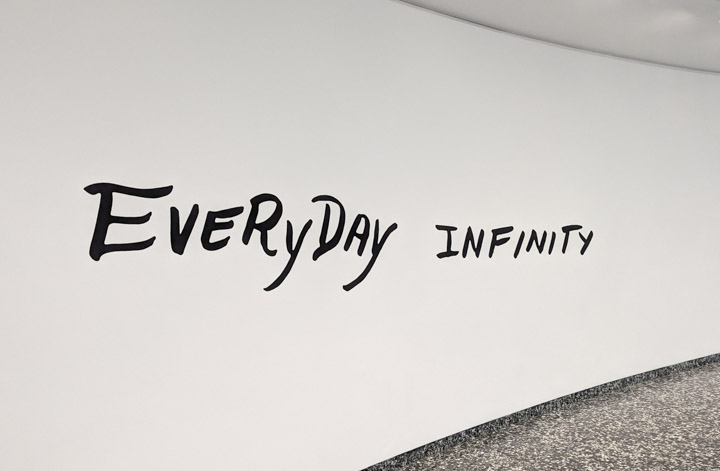
Above: Cupboard by
Simone Leigh.
Below: From Wheel of Life by
Jessica Diamond.
I hit the National Archive museum: Disappointing, unless you regard America’s founding documents as sacred texts. In and of themselves, they’re not much to look at.
Finally, the Museum of the American Indian. I found the collection a little thin, albeit with a clear-eyed view of all the lies and thefts and betrayals. But, that name…
The city
Washington is obviously kind of a company town and these days, most Federal departments only ask people to show their faces one day a week, usually Tuesday. It also suffers from the urban-American sin of being car-optimized, shot through with broad rivers of asphalt. Which, except for Tuesdays, are now pretty well empty. You can cross one of these six-lane behemoths more or less anywhere, any time. I understand the Mayor is furiously lobbying the Feds to arm-twist the civil servants back into the offices but it doesn’t look like it’s working.
The National Mall
It’s the big grass strip between the Capitol and the Washington Monument, dotted with Smithsonia and, on a chilly damp weekend day, hosting several flag-football games, well-organized and offering flashes of real talent. Heart-warming, I thought. Also a temporary white structure with music coming out of it and a sign saying “David’s Tent”. Hey, random free music is an opportunity and the door was open. It turned out to be a Christian worship joint and there was this frowning dude alone on stage strumming and singing: “holy, holy, holy” over and over. I only stayed inside for a minute or two and that was a lot of holy holies. There were two people in the front row of the front section, and as for the rest…

They need a better product manager.
Eventually I ended up on the Capitol steps, the same ones the Trumpers stormed that January 6th. Lots and lots of those sectional fences that failed so badly were still queued up there. I hoisted an end of one with one arm, no strain. I’m not sure what they’re for, actually.
Anyhow, here’s the view down the Mall from there. You might want to enlarge it.

This picture started out sort of dreamy and abstract, then I bashed the hell out of it with Lightroom and Silver Efex. I claim it looks like what I saw, only more so.
Wandering back
To my hotel I mean. The route went by an endless cavalcade of Congressional office buildings. Here’s one: check out the flag deployments, I guess we know where those particular congresspeople stand.

By this time, I’d touristed for enough hours that my feet were pretty sore and I was finding the serried office-block ranks sort of oppressive. Also, I was damn hungry, and then my life was saved by My Own Pizza, entirely unpretentious, selling good pies for a good price. All the customers were tourists with kids or local blue-collar workers, which in DC means Black. Way better vibe than my hotel bar.
On the last trudge of the day, this:

Asleep on a vent that I guess offers warm air. It’s raining.
These buildings host the wealthiest organization that has ever existed on this planet.
Lofree Flow 20 Jan 2024, 8:00 pm
Back in 2008, I complained here about Apple keyboards. Apple still hasn’t addressed my complaint (hard to believe, I know). So, 15 years later, as in late 2023, I picked up a Lofree “Flow”, which I gather had a Kickstarter and advertises itself as “The smoothest mechanical keyboard”. I’ve been using it long enough to offer opinions.
The problem with Apple keyboards is illustrated by the picture below; The Lofree is in the middle.

They’re all wireless. While the small Apple product at the bottom is really old, today’s equivalent has the same problems: There are no Home, End, PgUp, and PgDn keys, and the arrow keys are annoyingly small. The larger Apple at the top wastes space on the accountants’ number pad.
The LoFree is small enough and has the keys I want.
Why?
There are several places where I work regularly, and none of them feature a large desk, to the extent that if I have one or more of coffee, printed document, camera, or whatever else on the desk, things get crowded. So small is good.
Also, I use the navigation keys but never the number grid.
Also, those last few years at AWS a few of the engineers near where I sat had fancy keyboards with multiple colors and would argue about key-feel options.
Now, I generally like Apple keyboards and managed to avoid buying any of the infamous “butterfly” models. But there was this rave review in The Verge and I was trying to avoid some boring work that I was supposed to do, and there was a Black Friday sale, so here I am, my fingers now laying down a mellow rhythm section behind the creation of the prose melody you are now reading.
What’s good
The feel and the sound. I got the tactile “Phantom” keys rather than the linear “Ghost” option, so I can’t report on the latter, but I don’t play twitchy games and the consensus seems to be that tactile is good for a fast touch typist. I’m not as blindingly fast as I used to be but I’m still north of 100wpm. It may be relevant that I have big fat farmer’s fingers and have always hit keyboards pretty hard.
I’m struggling a bit for vocabulary to describe how this thing feels. I’ll settle for “eager” — the keys feel like they’re working with me to inject these blogwords into the noösphere.
As for the sound, it’s just delicious; low but distinct, and to my ears, euphonious.
Obvious problems
You might as well work with the thing plugged in, because the battery isn’t big enough and (perhaps to compensate) the Bluetooth goes to sleep quickly and (when unplugged) wakes up slowly.
The backlighting is lousy; it illuminates the edges of the keys adequately, but the letterforms only weakly. (Which for a touch typist is usually not a problem.) The “ambient” lighting is ridiculous; think of the flames on Wayne and Garth’s Mirthmobile. And if you have the lights turned up it runs the battery down even faster.
I should mention that the enthusiast community is annoyed that they have trouble (on some systems) customizing the keyboard layout, and that the selection of key options is limited. My modestly-customized Mac keyboard layout just worked.
Mobility
My biggest problem is that switching back and forth between the Lofree and an Apple keyboards makes my fingers clumsy for enough minutes to be annoying. Easy enough, just carry the Lofree around. It’s not big and despite the metal-not-plastic frame, is acceptably light. Except for, there isn’t a carrying case on offer. Which feels like a real miss.
Success?
Oh, definitely. Typing on it makes me happy. None of the problems interfere much given the way I use it. I guess the nav buttons are a little small but my fingers are starting to know where they are. Those big fat arrow keys are great. No, I’m not going to tumble over the edge onto the slippery slope of keyboard obsession. But this first step turned out fine.
Mourning Google 15 Jan 2024, 8:00 pm
On March 15, 2010, I started a new job at Google. The fourteen years since that day feel like a century. The title of my announcement was Now A No-Evil Zone and, OK, I can hear the laughing from ten timezones away. I tried, then, to be restrained, but there are hardly words to describe how happy and excited I was. I had escaped from the accretion disk the former Sun Microsystems was forming around Oracle, that blackest of holes. And Google, in 2010, was the coolest place in the world to work.
Let me quote myself from a little bit further into that piece, on the subject of Google: “I’m sure that tendrils of stupidity and evil are even now finding interstitial breeding grounds whence they will emerge to cause grief.” Well, yeah.
This is in my mind these days as I’m on a retired-Googlers mailing list where the current round of layoffs is under discussion and, well, it really seems like the joy has well and truly departed the Googleplex.
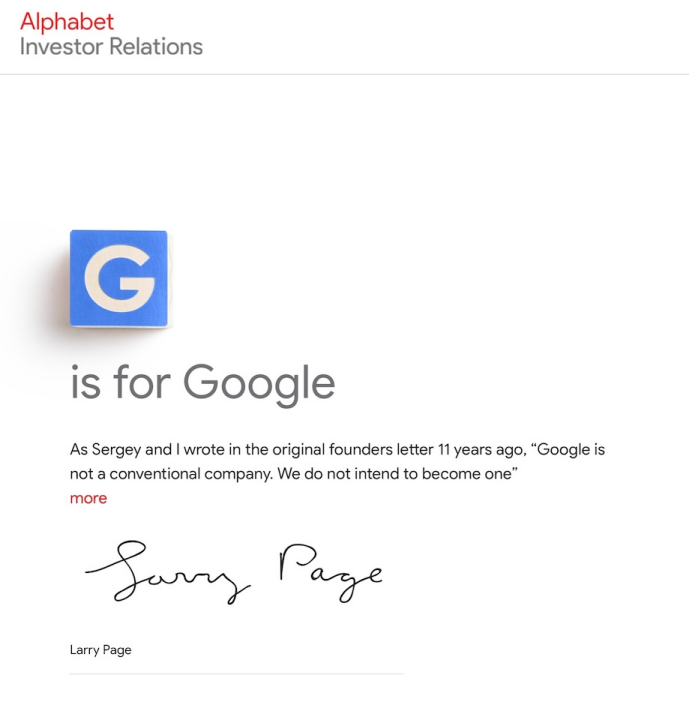
But they did.
(The Alphabet “Investor Relations” page
is also its home page.)
It’s not just Google
The last two decades of my career featured the arcing then crashing of popular regard for Big Tech. It’s hard to believe now, the years when those lovably nerdy Bay Area kids were leading humanity to a brighter, better-lit future; our leaders were lionized and when people found out you actually worked for Google, their eyes widened and you could feel the focus.
These days, Big Tech features in hostile congressional hearings, mass layoffs, and messy antitrust litigation. It offers few experiences that can be uncritically enjoyed.
While I was inside the Rooms Where It Happened, it was actually pretty hard to notice the public trust in our work auguring into the mountainside of alienation and cynicism. It’s not that I think the companies are the problem, it’s the machineries and imperatives of Late Capitalism, which for a while we foolishly thought Internet companies could route around.
“Ten blue links”
I remember the dismissive phase well: Ten blue links was boring, it was the past, it was not what people wanted. They want answers to their questions, complete and correct, so much more wholesome than an abbreviated sampling of the General Internet Uproar. And that was partly right: When I type in “-12C in F” or “population of vietnam” I just want a number.
But those Ten Blue Links surfaced by the PageRank-that-was had a special magic. I found them intensely human, a reflection of the voices populating what remains of the Web, the only platform without a vendor. This was true when I was there and I said so, but was laughed at.
And now, in Anno Domini 2024, Google has lost its edge in search. There are plenty of things it can’t find. There are compelling alternatives. To me this feels like a big inflection point, because around the stumbling feet of the Big Tech dinosaurs, the Web’s mammals, agile and flexible, still scurry. They exhibit creative energy and strongly-flavored voices, and those voices still sometimes find and reinforce each other without being sock puppets of shareholder-value-focused private empires.
Psychopaths
For my money, that was the center of Google’s problem. Larry and Sergey were smart guys who recognized they didn’t know shit about corporateness and quickly got into a pattern of hiring and empowering psychotic pricks who were presumably “good at business”. Not gonna talk about some of the things I saw because these people are wealthy and litigious.
But I do have a question.
What to use?
Among Google products, I mean. These days, when I use Google Search or Chrome or Maps I just don’t feel like they’re on my side. And maybe that’s not unreasonable; after all, I’m not paying for them. Problem is, the best alternatives aren’t obvious.
For now, here’s the direction I think I’m going: Use Chrome for Google stuff: Maps, Calendar, Docs, Translate. Safari and Firefox for non-Google stuff; they ain’t perfect but I think they’re better aligned with my interests.
Our family company is still on Google Workspace or whatever it is they call Dasher these days: Mail, Contacts, Photos, Calendar, Meet. It’s OK. We pay for it and the price is sane. I don’t feel like it’s looking for ways to monetize each keystroke. I’d totally consider a less-scary alternative.
I fear the combination of Google Maps and Reviews because it stinks of monopoly. But I use Maps anyhow in my car via Android Auto because it’s nicely integrated with YouTube Music (which I like) and Google Calendar. For a while I used the Here.com maps and liked them a lot. I guess I could listen to YouTube over Bluetooth.
Did I mention Android? I can’t stop using it, because I used to work in that building and because I decline to use iOS; If I wrote code for it I might not be able to give it away. And I carry Pixel phones, because I love the cameras. Having said that, hearing Andy Rubin’s name still makes my gut clench.
I love YouTube because I end most evenings, after everyone’s gone to bed, with a live musical performance by someone wonderful. But enshittification is creeping in at the edges.
That cafe
In 2012 I moved from Android to Google’s Identity group. It happened to be in the same buildings as Google+, at a time when Google was definitely putting all its wood behind that arrow. Larry and Sergey’s offices were there too (not a coincidence). There was a major fringe benefit: Access to the Cloud Café.
It was ethereal — OK, pretentious — almost beyond belief. Almost entirely vegetarian, rare plants hand-gathered by Zen monks and assembled into jewel-like little platelets-full that probably strengthened eleven different biochemical subsystems just by existing. And the desserts were beyond divine. Admittedly, sometimes when I left, my Norwegian-farmer metabolism grumbled a bit about not having had any proper food, but still.
It was wonderful. It was absurd. And I got a $90K bonus that year because Google+ hit its numbers.
It’s over, I think. It’s OK to miss it.
Five Electric-Jag Years 3 Jan 2024, 8:00 pm
I got a note from Jaguar advising that my free five-year “InControl Remote and Protect” subscription was expiring and would be $99/year (Canadian) going forward. That’s right, this month is five years since I picked up our 2019 Jaguar I-Pace and joined the EV tribe. Thus this (final?) visit to the Jaguar Diary series.
$99, you say?!
Yeah. What you get is a mobile app (and Web site) that does useful things, including:
Turn on the climate control to warm or chill the car while you’re having breakfast. This is a big deal in Canada.
Make it honk so you can find it in a big parkade.
Check whether you remembered to lock it, and do so if you didn’t.
Keep a diary of all your trips, which is nice and I guess super-useful if you expense your driving.
Since several of these require that Jaguar operate servers (hey, on AWS in Dublin) I guess I shouldn’t mind paying. Feels a little pricey but hey, I bought a Jag so I shouldn’t care? And I wouldn’t, except for they’re almost certainly harvesting data from the car like crazy and selling it. Which I call double-dipping.
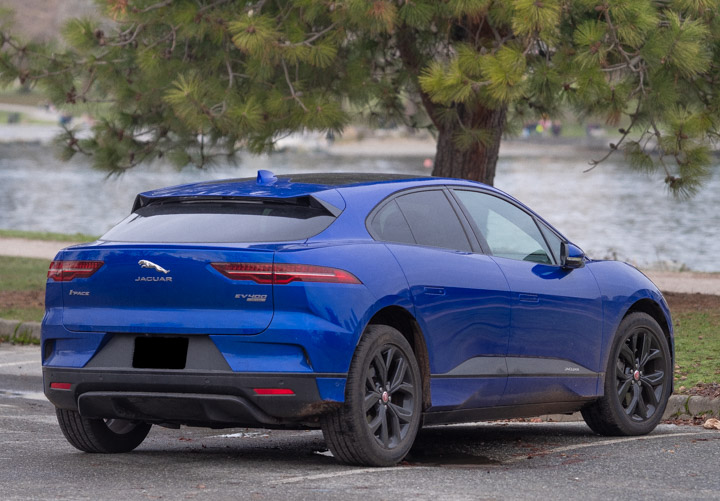
What about the car?
I have not regretted buying it for a single second of those five years. It’s comfy, faster than strictly necessary, reliable, practical, and cheap to run, even with that extra $99/year. Go read the other diary entries for that stuff. I guess the only thing to add is that, five years in, it still feels pretty well new. It’s fun to drive. The battery seems to hold about the same number of kilometres.
But #WarOnCars!
These days, my social-media feed contains many people who point out that Cars Are Bad and the spaces humans live in should be optimized for humans, and you Really Shouldn’t Like Cars.
And I agree, mostly. I totally want to choke cars out of the spaces we live in, to create a fifteen-minute city. Simultaneously, I like cars for their own sake, for their engineering and aesthetics, for the joy of being able to go from my front door to anywhere else on the continent while seated comfortably, listening to good music.
Yes, those viewpoints are in conflict but so what. People, statistically, also like alcohol and nicotine and speeding and adultery and Reality TV and junk food. And can agree, abstractly, that indeed, those things are bad. It all comes down to protect me from what I want.

There are two problems: First, the entire western edge of North America was built around sprawl and highways. Second, Late Capitalism’s egregious inequality has arranged that it’s hard for most people to afford to live near their jobs, or even where the public transit is good.
So yeah, as we develop our cities, let’s exclude cars to the extent possible. And let’s do something about the economy too. I will vote for regulations that restrict my use of my car. And to the #WarOnCars troops: I’m on your side, but don’t tell me I shouldn’t like them.
To start with, here’s a free idea: There should be a charge for occupying city space with your car, and it should depend heavily on the car’s size and weight.
EV trends
I suspect that central Vancouver has one of North America’s highest EV densities. On our block, our side of the street, are a Nissan Leaf, a Tesla, a Hyundai Kona EV, and me. And there’s frequently a Rivian parked out front, don’t know where it lives. In fact I’m starting to see a lot of Rivians. If you need a truck, the Rivian looks like a nice one, but I don’t think people in this neighborhood do.
When I bought the Jag I was worried it was like buying a PC in the Nineties; wait six months and there’ll be something way better. I got to test that hypothesis because a good friend just picked up a Hyundai Ioniq 6, 2023 World Car of the Year. We went for a drive and yeah, the state of the art has improved.
The Ioniq is, and feels, lighter than the Jag. It charges a lot faster. Its Android Auto implementation is nicer. The dashboard graphics are gracefully space-age. The shifter is clever and intuitive. No, it doesn’t have the Jag’s raw power or silky way through turns. But on balance, it is really a whole lot of car for the money. I’d buy one.
The most important electric vehicles aren’t going to be personal automobiles. They’re going to be the buses and trains that eventually come to fill in the public-transit grid and turn cars into rarely-needed luxury options. They’re going to be the trucks that are currently a huge source of carbon loading.
Cars will be with us for a while. But they should be lighter and smaller and fewer. And electric.
Happy New Year! 1 Jan 2024, 8:00 pm
Customarily, on this day we go for a walk by the sea. This year “we” was just me, because Post-Covid. I have pictures; subdued pictures, it was that sort of day. Herewith a few of those, and year-end ramblings on optimism, AI/ML, cameras, and social media.

Optimism?
The climate catastrophe is gonna get worse before it starts getting better. But I see rays of light that might illuminate 2024. I really don’t think the Americans are going to elect That Guy again. I think unemployment will stay low and worker power will increase correspondingly. I think there’s a significant chance we get a vaccine that actually stops Covid transmission, as opposed to today’s, which mostly just moderate its effects (still important of course). I think the health problems in my immediate family will improve a bit — Lauren is showing early signs of recovery from Post-Covid.
Did I mention the climate catastrophe? I hope our political leaders come to their senses, get out from under the Carbon Hegemony, and do the necessary things that will necessarily bankrupt much of the Petroleum sector. If they don’t, I think it near-inevitable that some of those defending the planet’s future will discard their commitment to non-violence. There is nothing people won’t do to protect their children.
Weirdly, and assuming that our species’ self-inflicted climate-disaster injuries aren’t fatal, there is an upside. This situation falsifies the central premise of Late Capitalism: That continued unending growth is essential, or even desirable. Particularly in the inevitable case where declining birthrates become pervasively global and there are fewer people each year needing goods and services.
Put another way: Jeff Bezos can blow off “Day 2” as much as he wants. But the Day-1 growth-at-all-costs dogma isn’t sustainable or even survivable. Day 2 is inevitable, and we need to learn how to make it good.

AI/ML
I’ve spent my working life in software, and AI seems to be the only thing anyone wants to talk about. I’m not smart enough to know where this tech ends up fitting in. Also, I’m arrogant: I don’t think anyone else is smart enough either. It’s painfully obvious that we’re in the midst of a bubble; just watch the VC froth. A lot of that money is going to the same place as the billions they gave to the crypto-bros.
I do have a recommendation: Assuming you’re busy and have a lot of input, don’t waste time reading “future of AI” predictions. Nobody knows.


Photography
When I went down to the sea, I took a Fujifilm X-Cam with the Samyang 135mm/F2 bolted on, and of course my Pixel. All but one of these pictures are Fuji/Samyang. This is my chance to opine, once again, that the best way to use a camera that’s not a phone is to strap a difficult and opinionated lens on it then follow where it leads.
I’m not that optimistic about the future of “real” cameras. When you watch the reviews from passionate camera-philes like Chris and Jordan over at Petapixel, you realize that, to the extent that newer cameras are better, the improvement is at the margins; for example, shooting elite athletes at a distance. All modern cameras take great pictures, most times. This notably includes the one in your phone; but its lens is the opposite of difficult.
2023 saw two real steps forward in camera technology: C2PA and global shutter. Global shutter is cool but of interest to only a few, and C2PA’s impact is strictly on the structure of belief; the technology itself is boring. Neither will help you get a better cat picture.


Social media
Most of my 2023 hours were filled by family health issues, my expert-witness gig with Uncle Sam, and what comes after Twitter. On the latter, I know only one thing for sure: That privately-owned centralized social media has not worked, will not work, can not work. Decentralized federation is the only sane path forward and we are right now making that up as we go along. Am I crazy to think that few things matter more than the forces that shape the broader human conversation?
I know that if you’ve been reading me at all, you’ve heard this enough, but forgive me, it’s too late to stop now: I think the member-owned social-media co-op we’re building at CoSocial offers a plausible glimpse of a resilient, fun, billionaire-proof social-media future. I’m an old guy but I’m as excited as a kid about this path forward.
This space
2024 will be this blog’s 21st year of operation. No month has had fewer than three pieces and my hope is to do as well or better going forward. Not writing feels like not breathing.
During the latter half of 2023, I produced two large legal submissions in connection with my Uncle-Sam gig, well over 400 pages in total. They are stuffed full of confidential information and will be read by only a small handful of people, then forgotten. That makes me sad, but producing them was still fun.
Back in 2018, I wrote enough Song of the Day pieces to fill a half-year’s days, and enjoyed it a lot. Most of the material was old; I was mining my own personal musical journey. Nothing wrong with that.
But these last few years, I’ve been listening to lots of new music and, once Uncle Sam has settled down, I’ll play a variation: Music of the Day. Most of it will be new-ish or at least new to me. And up front, I confess that most of that is driven by YouTube Music guessing what Tim might like. So don’t let anyone tell you I’m against AI in the general case.
Happy 2024, and good luck!
We’re going to need it.
Page processed in 2.433 seconds.
Powered by SimplePie 1.3.1, Build 20121030095402. Run the SimplePie Compatibility Test. SimplePie is © 2004–2024, Ryan Parman and Geoffrey Sneddon, and licensed under the BSD License.
